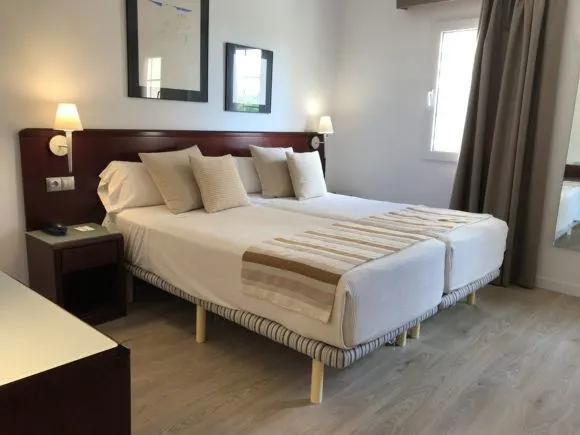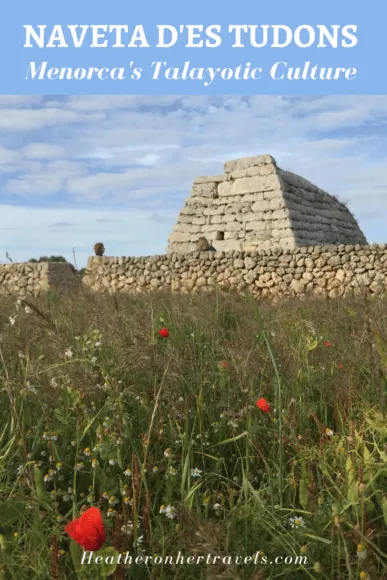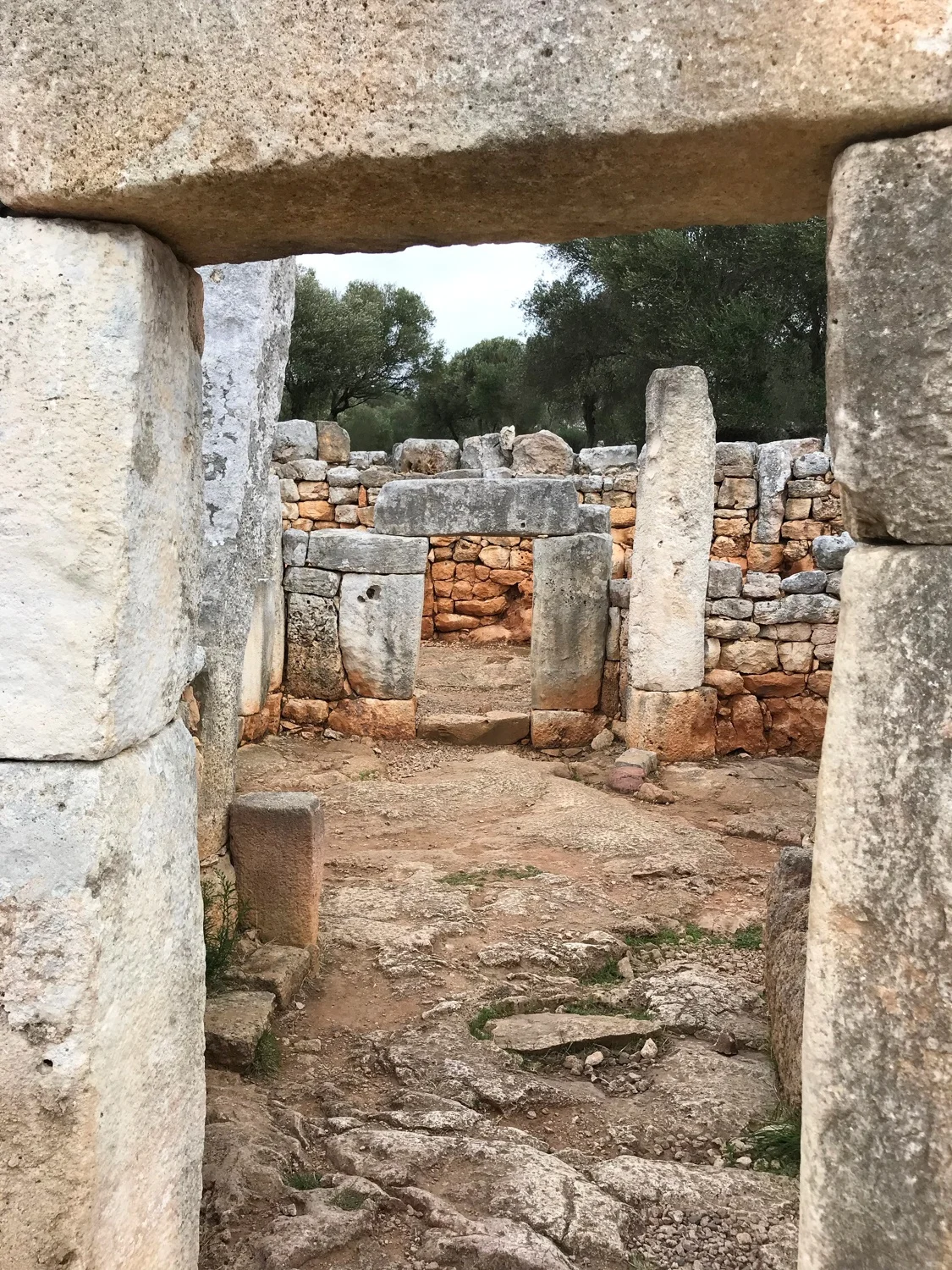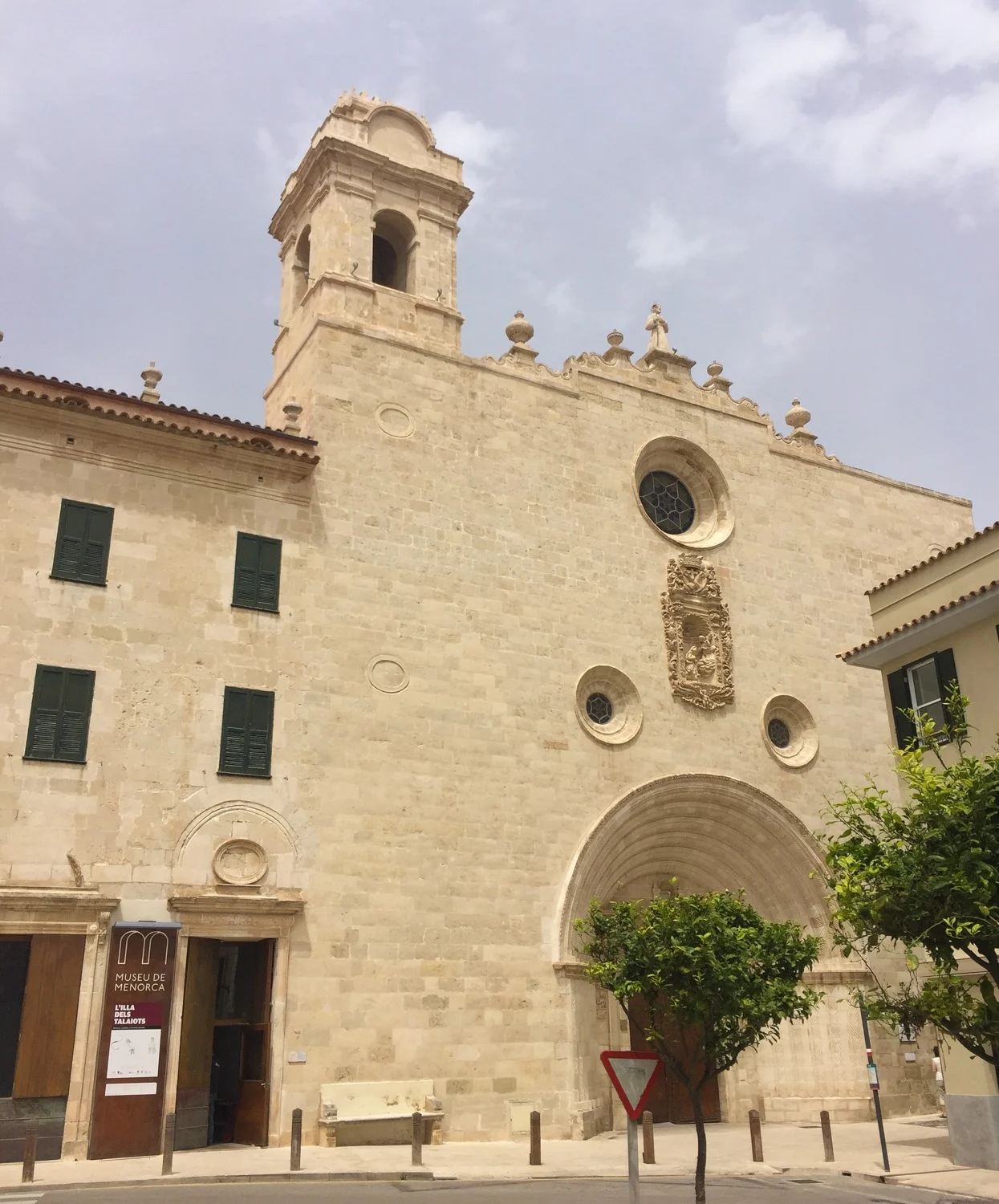As we walked along the grassy path, the stone monument stood solid, like an upturned boat. It is surrounded by a field of wildflowers and glowing in the late afternoon sun.
We’d come to visit the Naveta d’es Tudons, one of Menorca’s best known prehistoric monuments. This burial chamber dates back to around 1000 years BC, built by the people we know as the Talayotic culture.
This article may contain affiliate links that provide commission on purchases you make at no extra cost to you. As an Amazon Associate I earn from qualifying purchases.
Naveta d’es Tudons in Menorca
The Naveta des Tudons (Naveta being the Catalan word for boat) was excavated by archaeologists in the 1960s. The remains of over a hundred men, women and children had been laid to rest here. Findings included some of their personal possessions, such as metal hair ornaments or spear heads.
Once a body was placed inside the tomb, it was sealed and later the bones and skull would be moved to one side to make way for the remains of the next person.
All over Menorca you’ll find similar burial chambers, towers and settlements that are unique to the island. These are now being preserved with the aim of having them declared a UNESCO World Heritage site.
Since Menorca is an island where stone is readily available, the buildings of the Talayotic culture were left alone for us to visit today. Unlike other places where the stone would have been taken over the centuries for other buildings.
You may also enjoy: 15 fun things to do in Ciutadella – the ancient capital of Menorca
The legend of Naveta d’es Tudons
On our visit to Naveta d’es Tudons, we noticed how well it had been restored to its original appearance. All except the final stone that seemed missing from the parapet at one end.
Local legend has it that two giants sought the hand of the same girl and so to decide between them, each was set a task. One was to build a Naveta, the other to dig a well. Whichever could complete their task first would win the hand of the girl.
When the giant building the Naveta was carrying the final rock to place it in position, he saw his rival at the bottom of the well. He had just struck water, and in his anger threw down the stone and killed him.
Realising what he had done he ran away, so that the girl was left with neither suitor. Of course this explains what happened to the final stone to complete the Naveta d’es Tudons.
To visit Naveta d’es Tudons Menorca | The site is a 15 minutes drive from Ciutadella, just off the main Ciutadella – Mahon road. | If you don’t have a car it’s probably easiest to visit by taxi from Ciutadella and arrange a pickup time. | Allow 30 min- 1 hour to visit the site. | I believe there was a small charge to visit the site.

Stay at the modern Hotel Menorca Patricia in Ciutadella
Explore other hotels in Menorca
Naveta de Rafal Rubí in Menorca
While the entrance to the Naveta des Tudons was sealed, on another day Zoe Dawes and I were able to visit another of the Menorca ancient sites. We entered the similar tomb of Naveta de Rafal Rubí where there are two Navetas built close together.
These Navetas had not been restored and had a tumble-down appearance of a pile of rocks. The upper part of the Naveta had collapsed and the stones seemed to have disappeared.
If you want to see more of Menorca, check out this guided day trip with a walking tour. It takes you to Menorca’s ancient capital of Ciutadella and the Talayotic monument of Torralba
At the south Naveta de Rafal Rubí we clambered through the small, but finely cut square hole to stand inside, under the roof of huge stone slabs. Inside the tomb, it felt rather bare and bleak – probably not helped by the pouring rain.
All remnants of the past had been taken away to reside in one of the Menorca archaeology museums. Around the square opening was a lip, cut by expert stone masons of the Talayotic culture. This keeps the entrance stone in place that would seal the tomb.
You may also enjoy: A guide to the Cami de Cavalls in Menorca

A hidden Naveta
Without our guide, we would never have found this site, hidden away down a grassy path and surrounded by meadows and farm land. It reminded me of how Stonehenge, now complete with splendid new visitor centre, must have looked a hundred or so years ago. At that time it was just part of the farming landscape, surrounded by grazing animals.
If you’d like to take a full day tour of Mahon, check out this guided tour of Mahon and surrounding areas like Binibeca Vell and Cova d’en Xoroi

We moved on to the second of the two Navetas, the northern one. Again the upper chamber had collapsed, but this time we didn’t go inside.
Due to the pouring rain, it was not much of a day for lingering so we made our way back through the olive trees and stone walls to the road.
To visit Naveta Rafal Rubi | The monument is about 10 min drive from Mahon and is easiest to visit by car using Google maps. | The site is on private land with parking on the road.

Stay at the modern Hotel Menorca Patricia in Ciutadella
Explore other hotels in Menorca
Torre d’en Galmes in Menorca
In addition to the burial chambers like these Navetas, there are many conical structures around Menorca named Talayot, after the Spanish word atalaya or watchtower. It is from these that the Talayotic culture got its name
These towers demonstrate that the people had come together to live in larger settlements, with a highly organised culture.
You may also enjoy: 15 Things to do in Mahón, Menorca – if you only have one day
At Torre d’en Galmes, I was able to see some of the conical Talayot towers which seem to have doubled as living space with a watch tower on the upper level. The Talayots were normally situated within a settlement and also within sight of each other. It is thought that they might have been used as a network to signal from one to another in times of danger.
Another unusual feature of the settlements around Menorca are the Taules or T-shaped rocks. These are made of a slab of stone embedded in the ground with another rectangular stone on top.
The name Taule comes from the Catalan word for table, perhaps a table where giants would eat. Rather than being a balancing trick, I observed how a slot had been made in the upper rock to allow it to slot into place on the pillar rock.
This illustrates the advanced skills in working stone of the Talayotic people. The Taules are thought to have some religious or ritual significance. Perhaps they represent the horns of a bull or religious beliefs, just as Christians use a crucifix as a symbol of their religion.
A sense of scale and organisation
At Torre d’en Galmes I was able to sense the scale and organisation of the Talayotic settlements, with circular stone enclosures enclosing an inner courtyard. Different chambers and rooms were built around the circle for sleeping, storage and keeping animals.
The society was clearly well organised with a system of channels to collect rainwater and transport it to the underground reservoirs called Sitjots. In other places around the site, huge slabs of rock were balanced on stone columns to make shelters. These could have been used as storage chambers, topped with roofs of leaves and branches.
I wondered why such large slabs of stone had been used in this way to create walls and roofs. The effort involved to transport them and lever them into place was so enormous.
I later discovered that Menorca is an island with plenty of stone but very little wood. So, stone was used in the same way as huge oak beams might have been used elsewhere in Europe for building.
How to visit Torre d’en Galmes Menorca
- The site is in the south-east of the island between Alaior and Son Bou.
- By car – it is a 20 min drive from Mahon or 40 min drive from Ciutadella with free car parking at the site.
- By bus/ taxi – from Ciutadella take the #1 bus to Alaior or from Mahon take the #1, #32, #51, #71, #73 to Alaior – bus timetables on the tib Menorca website. Then from Alaior call a taxi to Torre d’en Galmes using the central number for taxis on Menorca or find the taxi rank in the town.
- Walking – If you are walking the Cami de Cavalls coastal path past Son Bou, it would be an easy detour to see Torre d’en Galmes.
- Allow 1-2 hours to see the site. There’s also an interesting visitor centre a short walk down the road. Get tickets from the kiosk at the site or the visitor centre.
If you visit Menorca, I hope you’ll take time to visit at least some of these unique prehistoric monuments and settlements that are dotted around the southern half of the island. There are 32 sites that are part of the UNESCO World Heritage proposal and maps are available from the tourism offices around the island.

Stay at the modern Hotel Menorca Patricia in Ciutadella
Explore other hotels in Menorca
You can also find more information on the Menorca Tourism website about the Talayotic route with a useful map of all the sites. The Menorca Arqueologica arrange regular group tours to see some of the main sites.
If you would like to engage a guide for an individual tour of the island’s Talayotic sites I can highly recommend Luis Amella of Menorca Guides.
Museums in Menorca that cover the Talayotic Culture
While in Mahon, I also visited a couple of museums to learn more about the Talayotic culture.
Ca n’Oliver – Centre d’Art i Història Hernández Sanz
In the Ca n’Oliver house in Mahon there was an interesting exhibition in the basement about the Talayotic culture. On display in one of the rooms were household pots and grinding stones, which were part of the collection of the house’s owner. Carrer Annuncivay 2, Mahon.
The Museum of Menorca in Mahon
The Museum of Menorca has galleries that cover the whole fascinating history of Menorca from the first inhabitants to the 19th and 20th centuries, including all the Talayotic history. Museo de Menorca, Avinguda del Doctor Guardia, Mahon.
Read Next
Walking in Menorca – on the Cami de Cavalls
More articles about Menorca
You’ll enjoy this video about the enchanting island of Menorca from Travel With Kat
Pin It For Later

Visitor Information for Menorca
To plan your holiday in Menorca and Mahón visit the Menorca Tourism website
For holidays in other parts of Spain you can find more information at Spain’s official tourism site
Looking for a guidebook for Menorca? We recommend the Rough Guide to Mallorca and Menorca to help you plan your trip.

Need a guidebook for Menorca? We recommend the Rough Guide to Mallorca and Menorca
Need somewhere to stay? Check out Hotel Menorca Patricia where we stayed in nearby Ciutadella or if this doesn’t suit you look at these other hotels in Menorca.
Looking for boat trips and activities on Menorca? Check out these guided tours and excursions.
If you need a guide to show you the sites of Mahon and Menorca, I can highly recommend Luis Amella of Menorca Guides
Thanks to Menorca Tourism for hosting* my stay in Menorca, in a project in partnership with Spain Tourism, Menorca Tourism and Travelator Media
* More info on my policies page
This article is originally published at Heatheronhertravels.com

















sunbonoo
Wednesday 22nd of June 2016
Hi Heather,
thanks so much for that very interesting article! The Talayots are well worth a visit, when you're staying in Menorca. Another famous, historic part of the island is the "way of horses" Camí de Cavalls. It was originally built all around the coast of the island to make it easier and quicker for the farmers to warn each other when pirates attacked. A few years ago, they started to restore the entire way and providing sufficient labelling, and it's a great route for hiking, biking or horseback riding.
Sunny greetings from Mallorca sunbonoo
Heather Cowper
Wednesday 22nd of June 2016
@Sunbonoo Thanks, yes I did a little bit of walking on the Cami de Cavalls but I know there's a lot more to explore
Gary Bembridge
Wednesday 15th of June 2016
Fascinating. Had no idea there was this heritage and history on Menorca. Quite different to my preconceptions about the place! Thanks for the insight!
Heather Cowper
Wednesday 15th of June 2016
@Gary It's a side of Menorca that certainly deserves to be better known
Zoë Dawes
Wednesday 15th of June 2016
Excellent article on the island's unique archaeological treasures. It's so unusual to have a Mediterranean island that combines wonderful beaches, pretty villages, interesting culture AND such a fascinating history. It was great to share it with you - especially sheltering from the rain in that isolated Naveta!
Heather Cowper
Wednesday 15th of June 2016
@Zoe Agreed, those remains definitely deserve to be made a UNESCO World Heritage site
Iain S Mallory
Tuesday 14th of June 2016
It's fascinating to understand the ancient culture of Menorca slightly better, thanks for sharing Heather. Even after our visit I wasn't really aware just how many prehistoric sites the island has. So cool you got inside Rafal Rubi.
Heather Cowper
Wednesday 15th of June 2016
@Iain Yes, I'd have liked to have seen a few more of these sites, incredible they are so well preserved but so little known.